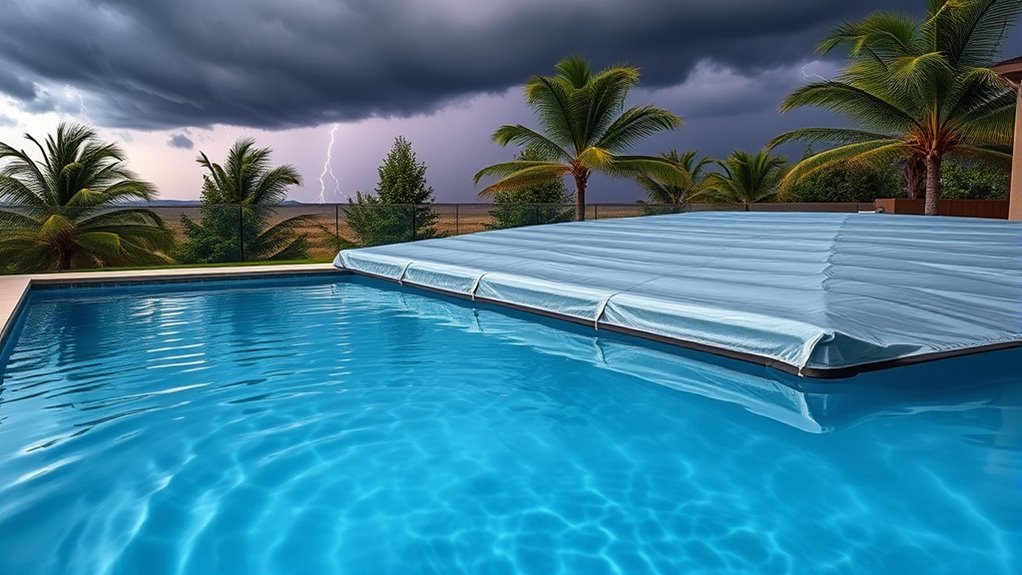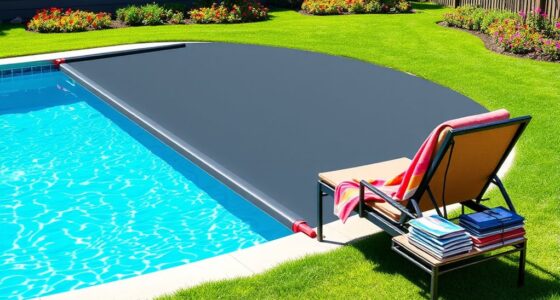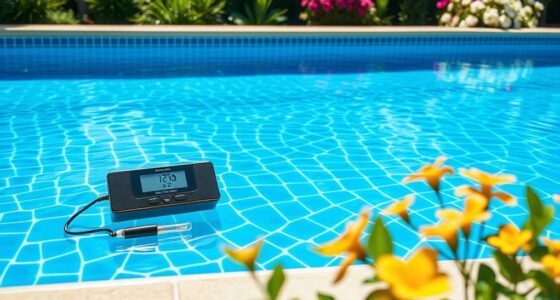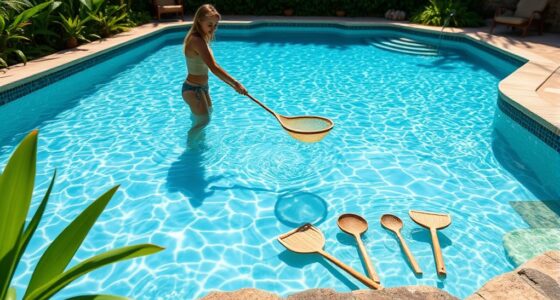To stay storm-ready, first assess and secure your pool area by removing loose objects, trimming nearby branches, and ensuring fences are secure. Use a high-quality cover and safeguard your equipment. Maintain proper water levels and chemical balance to prevent damage. Clear debris, ensure good drainage, and monitor weather updates regularly. After a storm, inspect for damage and clean thoroughly. Proper long-term maintenance boosts your pool’s resilience—continue exploring how to protect it effectively.
Key Takeaways
- Secure or cover the pool with a sturdy, properly anchored cover to prevent debris entry and protect from storm damage.
- Remove loose objects, outdoor furniture, and toys around the pool area to prevent them from becoming projectiles.
- Trim nearby trees and branches to reduce debris falling into the pool and avoid damage from overhanging limbs.
- Regularly inspect and maintain pool equipment and safety features to ensure proper function during storms.
- Monitor and adjust water levels and chemical balance before, during, and after storms to prevent damage and water quality issues.
Assess and Secure Your Pool Area Before Storms Arrive
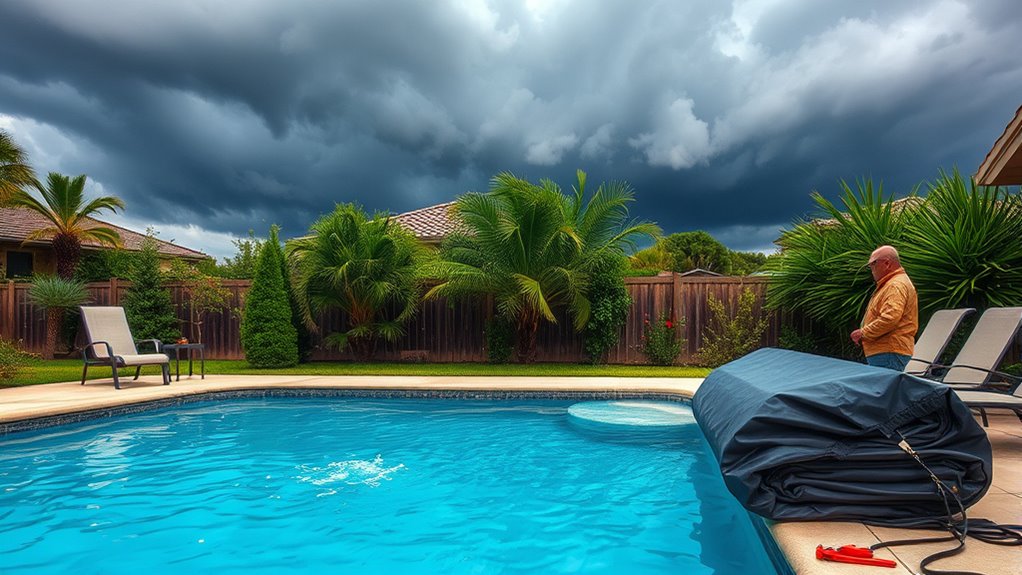
Before a storm hits, it’s vital to assess and secure your pool area to prevent damage and guarantee safety. Start by removing loose objects like furniture, toys, and umbrellas that could become dangerous projectiles. Check your pool safety equipment, such as skimmers and covers, to ensure they’re in good condition and ready for use. Trim nearby trees and branches that might fall or cause debris in the water. Secure or store pool accessories and chemicals safely inside to prevent spills or contamination. Make sure your pool cover is intact if you plan to use it, and verify that fencing and gates are secure to keep children and pets safe. Proper storm preparedness minimizes damage and keeps everyone safe during severe weather events. Additionally, reviewing your storm preparedness plan ensures you are ready to respond quickly in emergencies. Engaging in storm safety practices can further enhance your readiness and protect your loved ones. Regularly inspecting your pool area for potential hazards is also an important step in preventing damage, especially before adverse weather occurs. Consider also the importance of floating on water for safety and rescue preparedness in emergency situations.
Properly Cover and Shield Your Pool
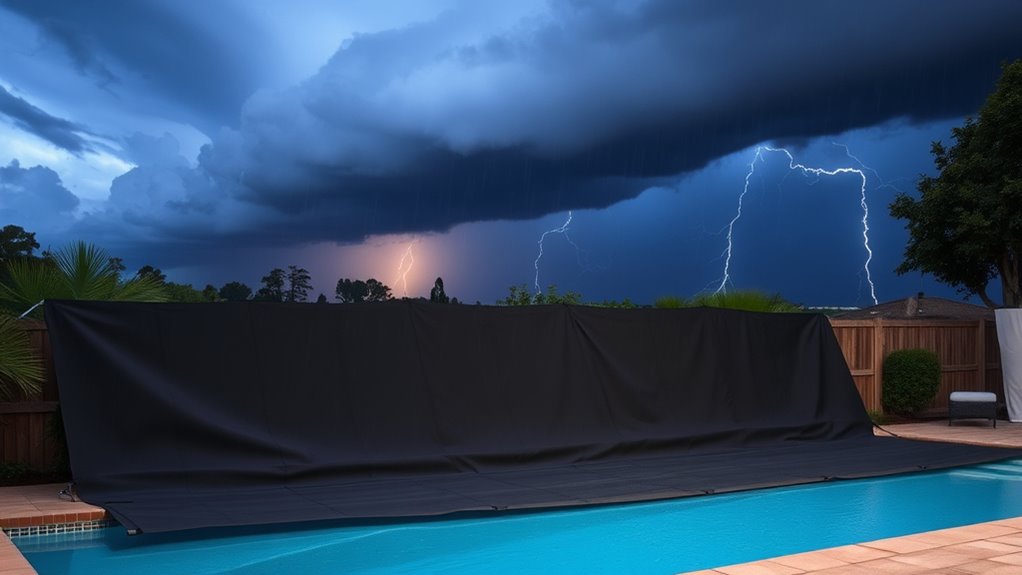
Covering and shielding your pool properly is vital to protect it from debris, dirt, and harsh weather conditions. The right pool cover selection ensures your pool stays clean and safe during storms. Choose from solid, mesh, or automatic covers based on your needs and weather risks. Proper installation is essential: ensure the cover is taut and secure around the edges. Safety fencing adds an extra layer of protection, preventing accidental falls and keeping children or pets away. Visualize the cover stretched tightly over the pool, with secure anchors and safety fencing surrounding the area. This setup creates a barrier, reducing the chance of debris entering and minimizing storm damage. A well-chosen cover and safety fencing are your first line of defense during bad weather.
Safeguard Pool Equipment and Accessories
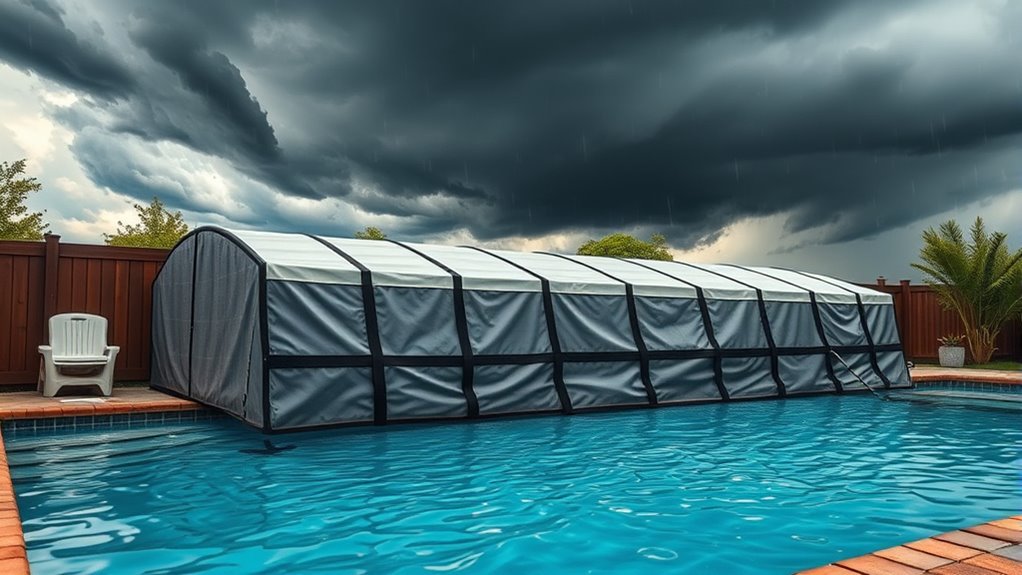
To guarantee your pool remains protected during bad weather, it’s important to secure your equipment and accessories. Start by choosing the right pool cover selection that can withstand wind and debris, ensuring your equipment stays dry and safe. Remove and store smaller accessories like pool toys, brushes, and cleaning tools in a dry, secure location to prevent damage or loss. For larger equipment such as filters, pumps, and hoses, use waterproof storage containers or shed units to shield them from moisture and harsh elements. Proper equipment storage not only prolongs the lifespan of your pool gear but also reduces cleanup efforts after storms. Additionally, understanding the contrast ratio of your pool lighting can help maintain optimal visibility during evening hours and adverse weather conditions. Incorporating emotional triggers into your safety preparations can motivate you to stay diligent and proactive about protecting your outdoor space. Staying informed about weather forecasts and AI-driven alerts can provide timely warnings to take necessary precautions. Regularly inspecting your self watering plant pots can serve as a reminder to keep your pool area tidy and secure, preventing accidents or damage. Being aware of storm preparedness strategies can further enhance your readiness for unexpected weather events. Taking these precautions helps maintain your pool’s condition and minimizes potential damage caused by bad weather.
Maintain Water Levels and Pool Chemistry
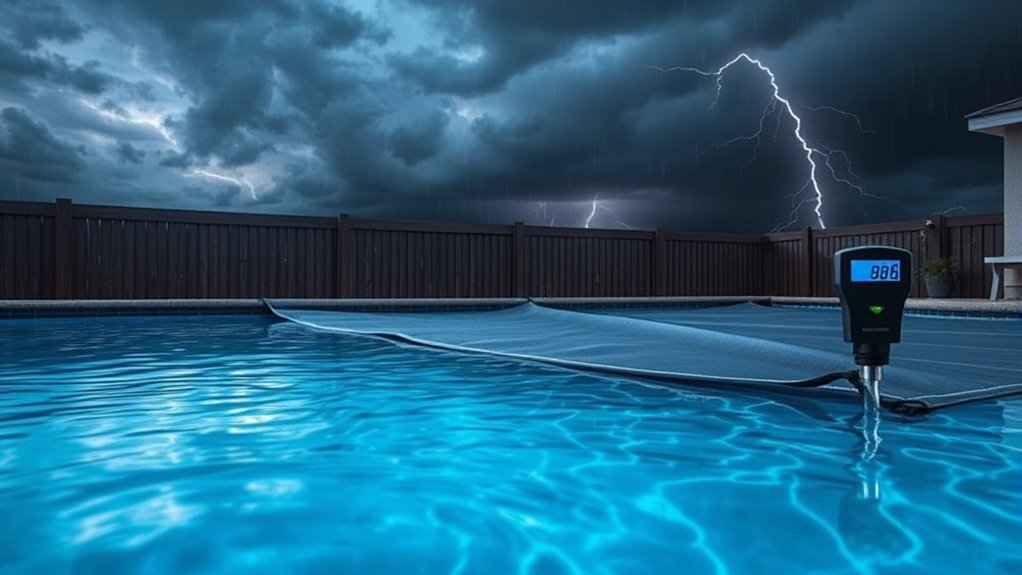
Maintaining proper water levels and balanced pool chemistry is essential for safeguarding your pool from damage and ensuring safe swimming conditions. Keeping your water levels steady prevents structural damage and guarantees proper filtration. You should also regularly check and balance your pool’s chemicals to keep the water safe and clear. Be cautious to avoid spills or overflows that could lead to chemical imbalances or messes. Regular testing and chemical balance help prevent issues like algae growth and equipment corrosion. Incorporating appropriate sound design techniques, such as ambient background sounds, can also help monitor and alert you to changes in water quality or equipment noise that may indicate problems. Additionally, understanding the weight of pool equipment can assist in proper installation and maintenance, especially during storms or when moving equipment around. Proper safety measures, including protective covers and secure fencing, are vital during bad weather to prevent accidents and unauthorized access. Staying informed about digital literacy in pool maintenance can improve your ability to troubleshoot and manage your pool effectively.
Monitor Water Levels Regularly
Monitoring your pool’s water levels regularly is essential, especially during bad weather when evaporation and runoff can quickly disrupt the water balance. Keeping an eye on the water level helps prevent damage to your pool’s structure and equipment. During storms or heavy rain, water levels can rise or fall unexpectedly, so you need to respond promptly. Use a reliable water level indicator or simply check the pool’s edge each day. Imagine:
- Water rising, threatening overflowing skimmers
- Sudden drops exposing pool tiles
- Excessive evaporation during hot, dry spells
- Heavy rain washing debris into the water
- Water level fluctuating with storm intensity
Maintaining proper water levels supports evaporation control and guarantees your pool remains safe and functional, even in turbulent weather. Regularly inspecting your filtration system ensures it continues to operate effectively, preventing clogs that could worsen during storms. Additionally, understanding water level management can help you anticipate and respond to changing weather conditions more effectively. Being aware of the correct water levels can also help prevent unnecessary strain on your pool’s equipment. Proper headphone maintenance can also be beneficial to ensure your audio devices are protected from weather-related damage when outdoors. It’s also helpful to familiarize yourself with storm preparedness tips to safeguard your entire pool area.
Adjust Chemical Balance Carefully
Since weather fluctuations can quickly throw off your pool’s chemical balance, it’s important to adjust chemicals carefully during storms and heavy rain. Regular chemical testing helps you identify changes in pH levels and sanitizer effectiveness. When adjusting pH, use pH adjustment chemicals cautiously to avoid overcorrection. Heavy rain can dilute sanitizer levels, so recheck and re-balance after storms. Here’s a quick reference:
| Action | Tip |
|---|---|
| pH Adjustment | Add small amounts, retest, then adjust further |
| Chemical Testing | Test frequently during and after storms |
| Chlorine/Bromine Levels | Rebalance to prevent algae growth |
| Water Testing Frequency | Increase testing to maintain proper chemistry |
Being aware of Volkswagen Tuning characteristics can help you understand how certain adjustments might impact your pool’s chemistry.
Prevent Chemical Spills and Overflows
To prevent chemical spills and overflows, maintaining proper water levels is essential, especially during heavy rain or hot weather. Ensuring your pool isn’t too full or too low helps with chemical spill prevention and overflow control. When water levels are off, chemicals can become unbalanced, increasing the risk of spills or overflow. Regularly check your water level and adjust as needed. Visualize the following:
- Water rising above skimmer opening
- Sudden surge during heavy rain
- Chemical imbalance causing cloudiness
- Pool overflowing onto decks
- Excess chemicals spilling over the edge
Keeping water levels steady prevents unintended chemical reactions and spills, protecting both your pool and surroundings. Proper maintenance allows safer chemical management and minimizes weather-related mishaps. Maintaining proper water chemistry is also crucial to prevent imbalances that can lead to spills or cloudy water.
Clear Surrounding Debris and Obstructions
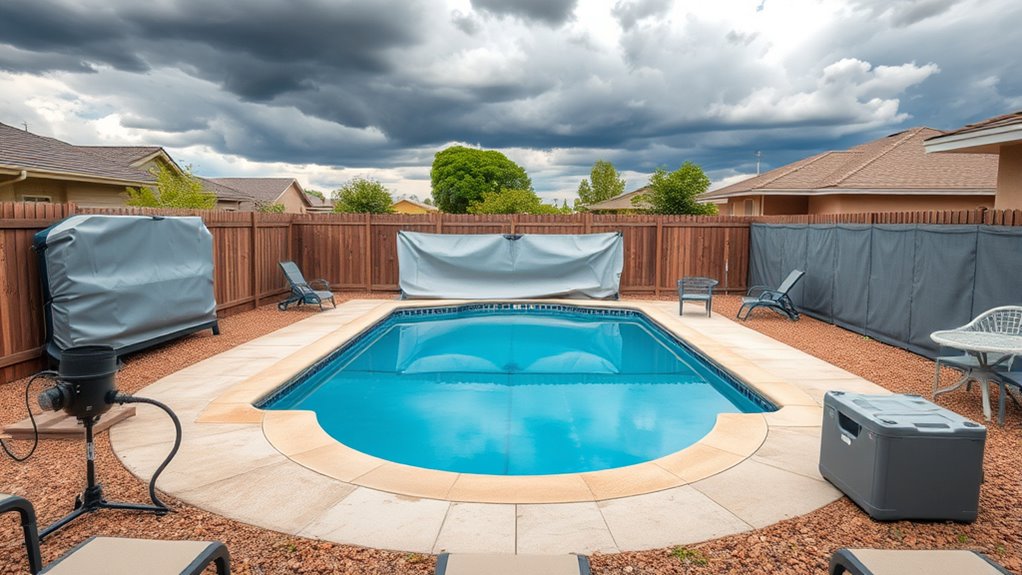
Before a storm hits, make sure to remove loose items like patio furniture and pool toys that could become projectiles. Trim back any overhanging branches or shrubs near your pool to prevent damage from falling debris. Clearing these obstructions helps protect your pool and keeps the area safe during bad weather. Engaging in preventive maintenance can also help develop problem-solving skills that are useful during emergency situations like storms. Additionally, understanding sound vibrations and their influence on cellular health can inspire you to incorporate calming music or sounds into your storm preparedness routines to promote relaxation. Recognizing the importance of proper drainage around your pool area can further minimize risks of flooding and erosion during heavy storms. Proper drainage systems can prevent water accumulation and protect your property from flood damage, aligning with retirement planning strategies that emphasize long-term security and risk mitigation.
Remove Loose Items
Removing loose items and clearing debris from around your pool is essential to prevent damage during bad weather. Loose debris can blow into your pool, clog the skimmer, or cause tears in your pool cover. By removing these items, you reduce the risk of damage and guarantee your pool stays protected. Take a quick walk around your pool area and gather:
- Toys and pool noodles
- Garden hoses and buckets
- Patio furniture cushions
- Loose leaves and twigs
- Unsecured umbrellas and tools
Storing these items safely inside or securing them tightly helps prevent them from becoming projectiles. Clearing debris also makes it easier to install or secure your pool cover properly. Being aware of electric power generation options can help you stay prepared for power outages during storms. Staying proactive now minimizes cleanup and repairs after the storm passes.
Trim Nearby Branches
Trimming nearby branches and clearing surrounding debris helps prevent potential damage to your pool during storms. Start with tree trimming to remove weak or overhanging branches that could fall during high winds. Branch removal reduces the risk of branches snapping and crashing into your pool or equipment. Use proper tools to cut back limbs that hang too close to the pool area, ensuring they don’t become projectiles in a storm. This process also keeps your pool cleaner by limiting leaves, twigs, and other debris that can clog filters or pollute the water. Regularly inspecting and maintaining surrounding trees is essential for storm preparedness. By proactively trimming branches and removing obstructions, you safeguard your pool and minimize cleanup after bad weather passes.
Ensure Proper Drainage Around Your Pool
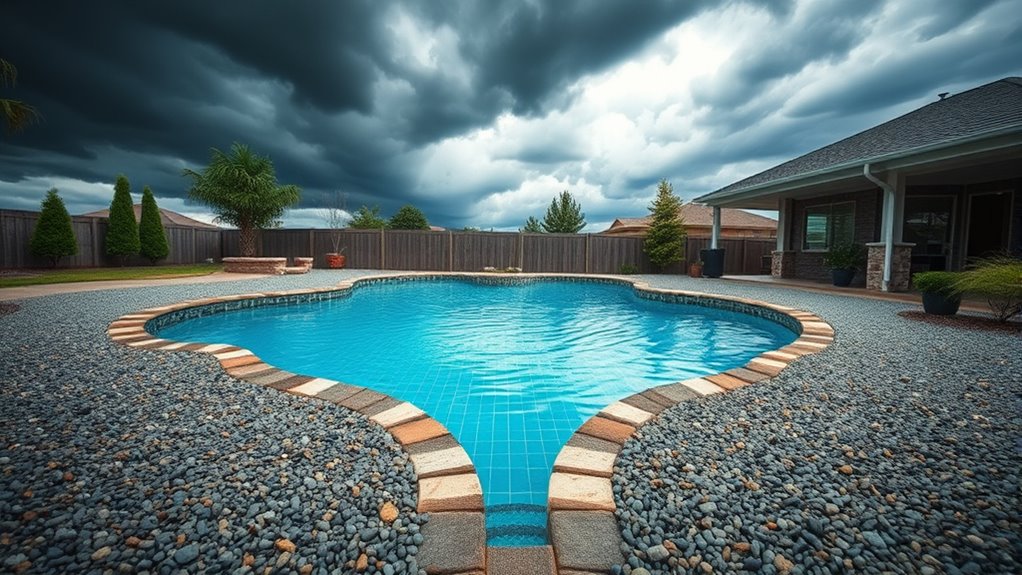
Proper drainage around your pool is essential to prevent water from pooling and causing damage during heavy rains or storms. Effective runoff management directs excess water away from your pool area, reducing the risk of erosion, flooding, and structural issues. To achieve this, consider implementing drainage solutions like French drains, swales, or catch basins that channel water safely away. Visualize:
Proper drainage protects your pool from water damage during heavy rains and storms.
- A gently sloping yard directing water away from the pool
- Perforated pipes hidden beneath gravel beds
- Curved landscape beds guiding runoff smoothly
- Raised borders preventing overflow
- Rain gardens absorbing excess moisture
These features work together to maintain proper drainage, protecting your pool and surrounding landscape from water damage. Consistent runoff management ensures your pool stays safe and functional through any storm.
Monitor Weather Alerts and Updates Regularly
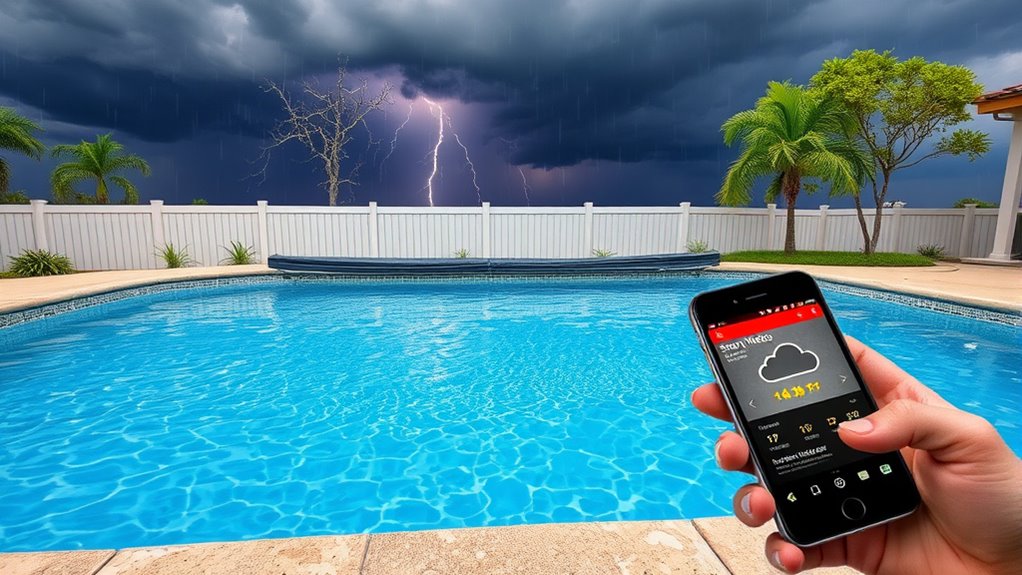
Staying informed about upcoming weather conditions is essential for protecting your pool during bad weather. Use reliable weather apps to receive real-time updates on storms, heavy rainfall, or high winds. These apps often send emergency alerts directly to your phone, guaranteeing you’re promptly notified of worsening conditions. Regularly checking weather updates allows you to act quickly—covering your pool, securing loose items, or draining excess water if needed. Subscribing to local weather alerts guarantees you don’t miss crucial warnings, even when you’re away from home. Being proactive with weather monitoring helps you make informed decisions to safeguard your pool and property. By staying vigilant and utilizing technology, you reduce the risk of damage caused by unexpected storms or severe weather.
Post-Storm Inspection and Cleanup Procedures
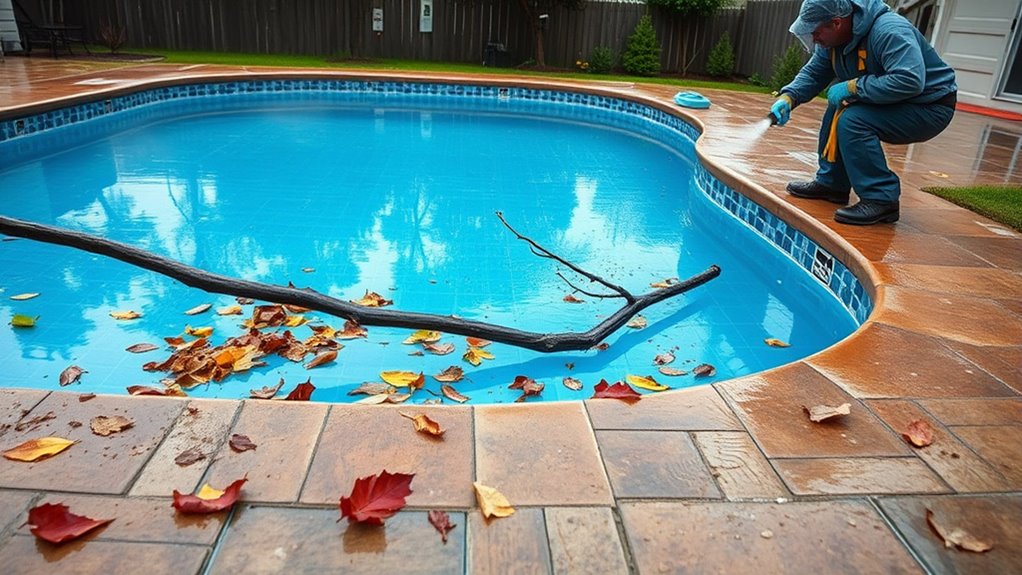
After a storm passes, it’s essential to inspect your pool and surrounding area thoroughly to identify any damage or safety hazards. Check for debris, broken equipment, or cracked tiles that could compromise pool safety. Remove fallen branches, leaves, and trash from the water and deck to prevent clogs and accidents. Examine the pool’s structure for leaks or cracks, and ensure electrical components are dry and undamaged.
Visualize clearing:
- Twigs and leaves floating on the surface
- Broken pool toys and debris on the deck
- Damaged skimmer baskets and filters
- Cracks or chips in tiles or walls
- Wet electrical outlets or equipment
This cleanup supports storm preparedness and keeps your pool safe for future use.
Long-Term Maintenance for Storm Resilience
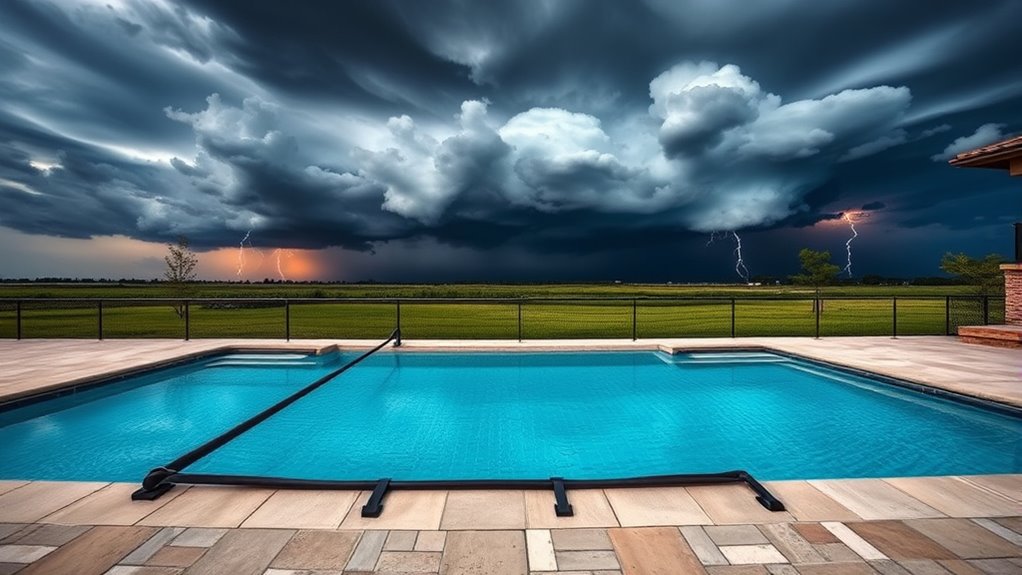
To guarantee your pool can withstand future storms, implementing long-term maintenance strategies is essential. Start by regularly inspecting and maintaining your pool cover selection to ensure it provides ideal protection during severe weather. A durable, storm-resistant cover can prevent debris buildup and minimize damage. Additionally, consider reviewing your storm insurance policy to confirm it covers storm-related damages and includes appropriate coverage for your pool. Keep your pool equipment well-maintained to prevent malfunctions during storms. Clear surrounding areas of loose objects that could become projectiles. Regularly checking and updating your storm preparedness plan helps you respond quickly when bad weather approaches. These proactive steps help bolster your pool’s resilience, reducing potential damage and ensuring your pool remains intact through future storms.
Frequently Asked Questions
How Often Should I Review My Pool’S Storm Safety Plan?
You should review your pool’s storm safety plan at least once a year, especially before the storm season begins. Regular emergency preparedness checks and safety drills help make sure everyone knows what to do during bad weather. Keep your plan updated with new contact info or safety procedures. Consistent reviews make sure your family stays prepared, reducing risks and ensuring swift, confident action when a storm approaches.
What Are the Best Materials for Pool Covers in Storms?
Think of your pool cover as a sturdy shield against storms. You want materials with high durability, like reinforced vinyl or safety mesh, that can withstand strong winds and debris. Proper cover installation techniques are vital, ensuring the cover fits tightly and stays secure. This way, you protect your pool from damage, much like a knight’s armor guards a castle, giving you peace of mind during bad weather.
How Can I Prevent Algae Growth After a Storm?
After a storm, you can prevent algae growth by ensuring your pool’s chemical balance is correct, especially maintaining proper pH and chlorine levels. Remove debris promptly to prevent organic material from fueling algae. Regularly brushing the pool walls and bottom also helps prevent algae from taking hold. By staying on top of chemical adjustments and debris removal, you’ll keep your pool clean and algae-free despite the weather.
Are There Specific Signs Indicating Pool Equipment Damage?
When your pool equipment whispers warnings, don’t disregard them—these are signs of potential damage. Look for leaks, strange noises, or inconsistent operation, which signal trouble ahead. Damage signs include broken gauges, loose fittings, or rust. Addressing these issues promptly can prevent costly repairs. Remember, your pool equipment is the heart of your oasis—caring for it guarantees your backyard paradise stays safe and inviting, rain or shine.
What Insurance Coverage Is Recommended for Storm-Related Pool Damage?
You should consider extensive homeowners insurance that covers pool damage, especially from storms. Make sure your policy includes coverage for storm-related pool damage to simplify insurance claims after bad weather hits. Keep detailed records of repairs and damages, and document the damage with photos. Contact your insurer promptly to start the claims process, ensuring you understand what’s covered and what isn’t, so you can protect your investment effectively.
Conclusion
By staying proactive and prepared, you can weather any storm that comes your way. Take the time to secure your pool area, protect your equipment, and stay alert to weather updates. When the skies clear, don’t let things fall through the cracks—inspect, clean, and make any necessary repairs. Remember, a stitch in time saves nine, so being vigilant now keeps your pool safe and ready for sunnier days ahead.

